This post may contain affiliate links. Please read our disclosure policy.
Cardamom-infused buns filled with eggless almond paste and a generous amount of whipped cream and a sprinkle of powdered sugar.

What is Swedish semla (semlor) ?
The Swedish Semla, a delightful almond paste (mandelmassa) and cream-filled bun, has become an iconic symbol in Sweden, especially during the fasting period of Lent. Over time, the recipe evolved, transforming the humble bread into the indulgent treat we know today.
Why is it called Fat Tuesday buns ?
The name “Fat Tuesday” refers to consuming richer, fatty foods on this day before the fasting season begins. It is a day of feasting, revelry, and merriment, with people indulging in decadent meals and treats. So, many people in Sweden will indulge in this delightful treat to embrace the joy of the season! They are great with a cup of tea or coffee. Some people like to dip the buns in warm milk to enjoy this treat.
Almond paste vs Marzipan
From what I heard, almond paste is usually used in baking and is widely available in Europe. Not here where I am though. But making almond paste is not hard at all, especially with the widely available almond flour these days. You don’t need to make the almond flour (or some call it almond meal) from scratch. Almond paste usually contains 1:1 almond-to-sugar ratio whereas marzipan is usually used in candy-making and is much sweeter than almond paste. Marzipan can contain a 3:1 to 4:1 almond-to-sugar ratio.

Swedish Semla/Semlor (Fat Tuesday Buns)
Ingredients
- 250 g bread flour 12.7% protein content
- 4 g instant yeast
- 40 g sugar
- 10 g milk powder
- 1 tsp ground cardamom
- 3 g salt
- 50 g egg 1 large egg
- 80 g whole milk or more as needed
- 40 g unsalted butter softened
Egg wash:
- 1 egg
- 1 tsp milk
Almond paste (eggless):
- 50 g almond flour finely ground
- 50 g powdered sugar
- 15 g heavy cream or more as needed
- 1 tsp almond extract
Whipped cream:
- 200 g heavy cream
- 20 g powdered sugar plus more for dusting
Instructions
Prepare the dough:
- Mix all the dry ingredients together in a mixing bowl. Make a well in the center and pour in the wet ingredients. Use a dough hook attachment to knead the dough on speed 2 until all the crumbly dough starts to come together into one mass, it may take about 2-3 minutes for this to happen. Don't be tempted to add any liquid. You may need to stop halfway and scrape the dough off the hook and the sides of the bowl and knead again for another 3 minutes
- Gradually add in the softened butter bit by bit. The dough will turn into a sticky mess again because of the butter. Just keep kneading and stop halfway and scrape the dough off the hook and bowl again and continue to knead until the butter is absorbed by the dough. IT WILL HAPPEN, don't worry! DO NOT be tempted to add any extra flour. You will get a shiny smooth dough that is very elastic. This may take about 5-8 minutes on speed 4, depending on your mixer too. The dough must pass a windowpane test, meaning, when you stretch a small amount of dough thinly, it won't break and a light can pass through
1st proofing:
- Place this dough in a lightly oiled large bowl, cover it with a clean and damp tea cloth or plastic wrap and let it rise at a warm place until almost double or double in size. This may take about 1 hour or longer depending on temperature.
- When you poke the dough with your lightly-floured finger, the indentation stays.
Prepare the almond paste:
- While the bread is proofing, prepare the almond paste. Simply combine all the ingredients in a bowl to form a dough-like consistency. You can also put them in a food processor and process until it is dough-like. Cover and set aside. If you are making this ahead of time, wrap it well and store it in the fridge
Shaping:
- Line a large baking pan with parchment paper. Degas the dough by punching it down and then divide into 10 buns, roughly the same size or weight. Keep them covered and rest for 5 minutes to relax the gluten
- Work with one dough at a time. Take one dough and flatten with your palm and then pull the edge towards the center, going around all the edge to form a tight dough ball. Repeat with the rest of the dough
Final proofing:
- Let them proof again for another 45 minutes to 1 hour, depending on the temperature, or until they are really puffy.10 minutes before the end of proofing, preheat the oven to 400 f (200 C) for conventional oven, 375 F (190 C) for convection oven
- If you gently press on the dough, it will bounce back very slowly and leave an indentation. If it bounces back right away, proof a bit longer
- Combine egg with milk to make the egg wash. Make sure you whisk the egg really well. Brush on top of the bun
Baking:
- Place the pan on the middle rack and bake for 10-12 minutes or until golden brown or the inner temperature in the center is 190 F. Do not overbake as it will dry out the crumbs and the bread won't stay soft the next day. I highly recommend a digital thermometer if you bake often as it helps to clear out that doubt whether the bread is baked through or not
- Remove from the oven and let them cool down on cooling rack completely before assembling
Prepare the whipped cream:
- Prepare whipped cream by whipping the heavy cream with powdered sugar on medium speed until it thickens and hold its peak. Make sure not to overwhip though, the cream turns grainy when it is overwhipped. Transfer to a piping bag with a large nozzle of your choice
Assembling:
- Cut the top part of the bun. Use a sharp knife to cut out some of the crumbs from the bottom bun to create some space for the almond paste. Take care not to cut too deep though. Don't throw away the scoop-out crumbs. You can always turn them into breadcrumbs or eat them with cream 🙂
- Pipe the whipped cream on top. Place the top put of the bun back on top (it's like the bun is wearing a little hat!). Dust with some powdered sugar and serve immediately
Storage:
- Store the unassembled buns at room temperature in an air-tight container for 3 days. Once assembled with filling and cream, you have to keep them in an air-tight container in the refrigerator. The longer they are kept in the fridge, the drier the bread will get
- I recommend only filling the buns whenever you are ready to serve. That way, you can store the almond paste and cream in the fridge and the buns can be kept at room temperature for a few days or in the freezer for a month until you are ready to serve them
*Nutrition facts are just estimates and calculated using online tools*
How to bake Swedish semla/semlor
1. Mix all the dry ingredients in a mixing bowl. Make a well in the center and pour in the wet ingredients. 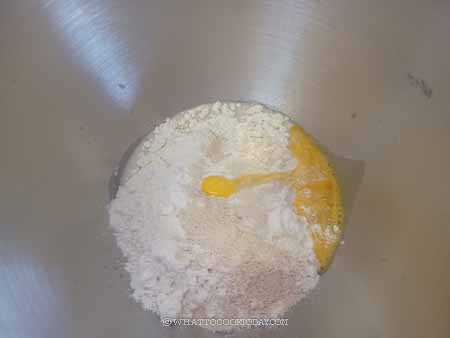
2. Use a dough hook attachment to knead the dough on speed 2 until all the crumbly dough starts to come together into one mass, it may take about 2-3 minutes for this to happen. Don’t be tempted to add any liquid. You may need to stop halfway and scrape the dough off the hook and the sides of the bowl and knead again for another 3 minutes. Gradually add in the softened butter bit by bit. The dough will turn into a sticky mess again because of the butter.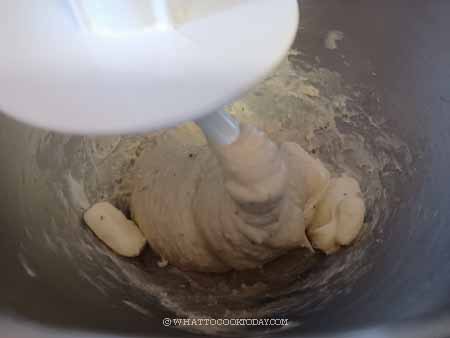
3. Just keep kneading and stop halfway and scrape the dough off the hook and bowl again and continue to knead until the butter is absorbed by the dough. IT WILL HAPPEN, don’t worry! DO NOT be tempted to add any extra flour. You will get a shiny smooth dough that is very elastic. This may take about 5-8 minutes on speed 4, depending on your mixer too. The dough must pass a windowpane test, meaning, when you stretch a small amount of dough thinly, it won’t break and a light can pass through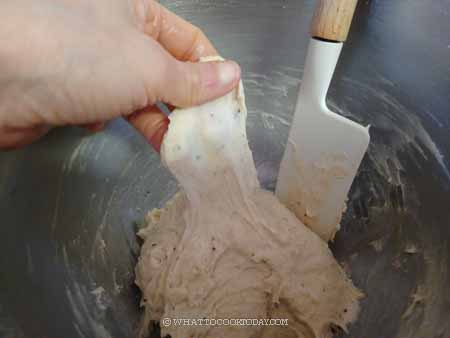
4. Place it in a lightly oiled bowl and let it rise in a warm place for about 1 hour or longer depending on the temperature. It will double in size. In wintertime, I use my oven bread proof function to do this.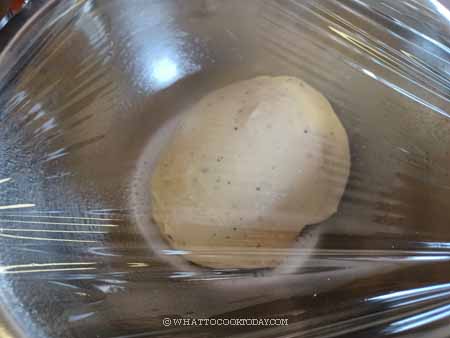
5. When you poke the dough with your lightly-floured finger, the indentation stays.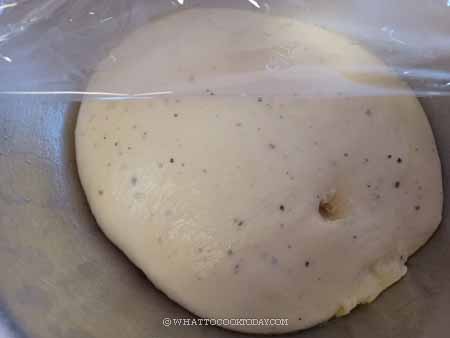
6. While the bread is proofing, prepare the almond paste. Simply combine all the ingredients in a bowl to form a dough-like consistency. You can also put them in a food processor and process until it is dough-like. Cover and set aside. If you are making this ahead of time, wrap it well and store it in the fridge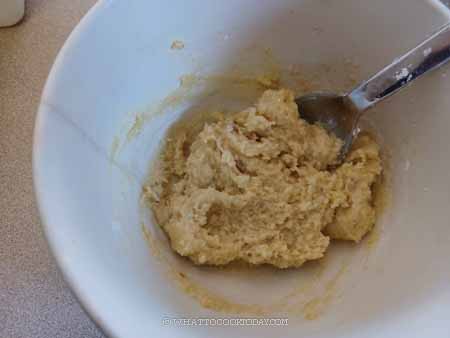
7. Line a large baking pan with parchment paper. Degas the dough by punching it down and then divide into 10 buns, roughly the same size or weight. Keep them covered and rest for 5 minutes to relax the gluten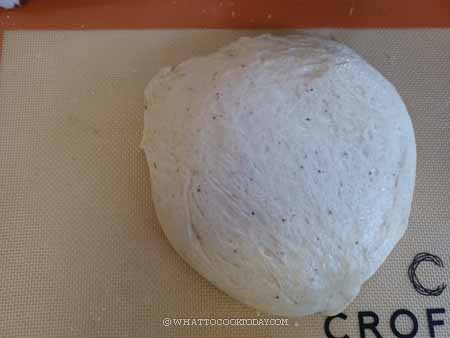
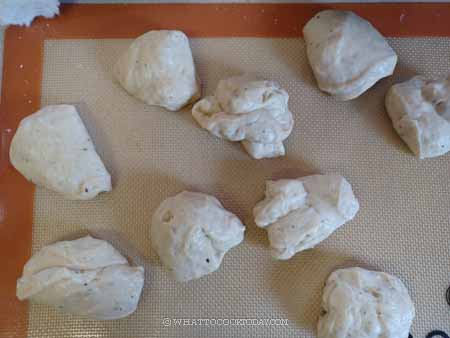
8. Work with one dough at a time. Take one dough and flatten with your palm and then pull the edge towards the center, going around all the edges to form a tight dough ball. Repeat with the rest of the dough
9. Let them proof again for another 45 minutes to 1 hour, depending on the temperature, or until they are really puffy.10 minutes before the end of proofing, preheat the oven to 400 f (200 C) for conventional oven, 375 F (190 C) for convection oven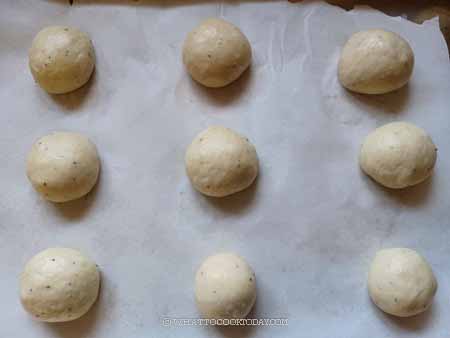
10. If you gently press on the dough, it will bounce back very slowly and leave an indentation. If it bounces back right away, proof a bit longer. Combine egg with milk to make the egg wash. Make sure you whisk the egg really well. Brush on top of the bun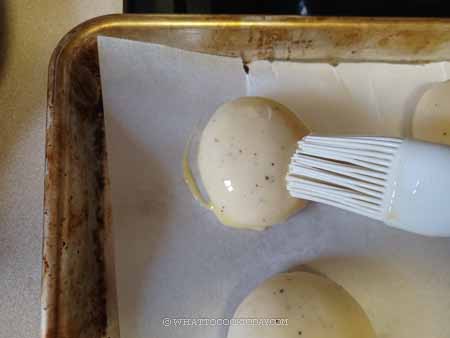
11. Place the pan on the middle rack and bake for 10-12 minutes or until golden brown or the inner temperature in the center is 190 F. Do not overbake as it will dry out the crumbs and the bread won’t stay soft the next day. I highly recommend a digital thermometer if you bake often as it helps to clear out that doubt whether the bread is baked through or not. Remove from the oven and let them cool down on cooling rack completely before assembling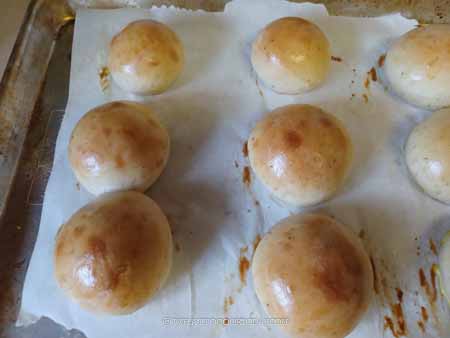
12. Prepare whipped cream by whipping the heavy cream with powdered sugar on medium speed until it thickens and hold its peak. Make sure not to overwhip though, the cream turns grainy when it is overwhipped. Transfer to a piping bag with a large nozzle of your choice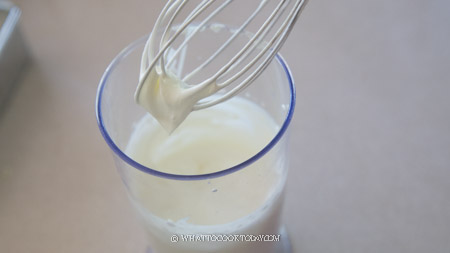
13. Cut the top part of the bun. Use a sharp knife to cut out some of the crumbs from the bottom bun to create some space for the almond paste. Take care not to cut too deep though. Fill it with almond paste, about 1-2 teaspoons or to your taste. Don’t throw away the scoop-out crumbs. You can always turn them into breadcrumbs or eat them with cream 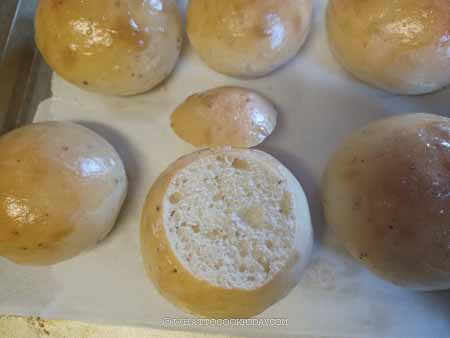
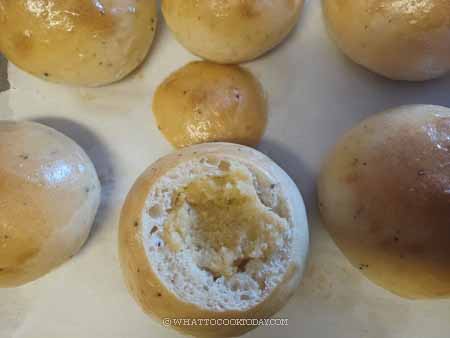
14. Pipe the whipped cream on top. Place the top put of the bun back on top (it’s like the bun is wearing a little hat!). 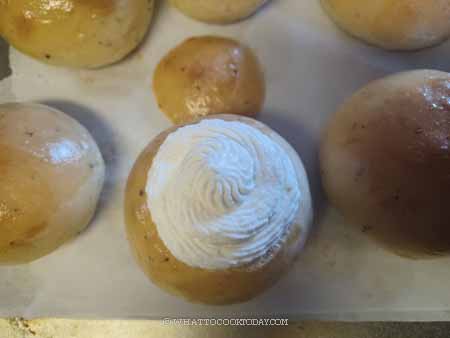
15. Dust with some powdered sugar and serve immediately

Did you make this Swedish semla/semlor recipe?
I love it when you guys snap a photo and tag it to show me what you’ve made. Simply tag me @WhatToCookToday #WhatToCookToday on Instagram and I’ll be sure to stop by and take a peek for real!

